By The Crusader Editorial Board
Originally published on The Crusader News: https://thecrusader.news/2024/06/14/the-black-national-question-and-the-black-belt-thesis/
Note from the Editorial Board of The Masses: We requested to republish this article which we found to be an insightful and thorough analysis of the question of Black liberation in the so-called united states. We commend the comrades at The Crusader for putting this together, and highly recommend our own readers to browse their publications on The Crusader’s web site, linked above.
Note
This article is the first in a series of articles attempting to outline a scientific and materialist outline on the national character of the Black population in the U.S. today. Throughout this piece, we will refer to the nation oppressed by U.S. Imperialism as “Black American” in order to make the distinction between the specific culture of the descendants of enslaved Africans in the U.S. and “Black” as a race, birthed from the pseudo-scientific concept and institutional reality used to justify the oppression and colonization of Africans.
Introduction
Our first article titled “Race Traitor: White Workers and Organizing Against White Supremacy” drew some criticism online on the basis of its focus on the white sections of the proletariat. Why would a revolutionary Black newspaper try to win sympathetic whites? Should our orientation not be towards the Black proletariat and building a strong movement among the Black masses? Perhaps the most offensive criticisms levied at our publication were that we were a group of white activists masquerading as Black writers in order to win Black people over to communism. This particular attack is rooted in historic racist propaganda claiming that it is not “in the nature” of Black people to struggle for communism.
Of course we believe that a strong Black nationalist movement must be organized, and that revolution in the United States is inconceivable without Black liberation. The Crusader aims to serve this purpose. Simultaneously, as Marxist-Leninist-Maoists we believe in a unitary Communist Party is necessary for the victory against U.S. Imperialism, which entails uniting the proletariat of both the oppressed and oppressor nations, with the proletariat of the oppressed nations leading the struggle. The Communist Party gets its name and class character from the fact that it is the most class-conscious section of the proletariat across race and nationality. Thus the task of illuminating the different nations’ relations to each other is crucial, as is the question of assimilation. In our first article, when we stated “It is [our] observation that many oppressed-nations activists who join predominantly white organizations are those who have assimilated to some degree to the cultural norms of whiteness or at the very least, have had enough exposure to it so as to not feel alienated from these environments. This is not the case for many workers of the oppressed nations…”, we highlighted this to demonstrate that assimilated oppressed-nations comrades most likely do not constitute the lowest and deepest masses of our people, and thus present a potential blindspot to these predominantly-white organizations’ ability to understand the national question.
There are other ideological and political shortcomings with our first piece, but to sum: it will not do to only require that Black workers and other nationally oppressed peoples be the only ones with an understanding of race and national oppression; in order that our own struggles may succeed, in order to unite the entirety of the class, we also have to address the shortcomings of white organizations so that they can render better assistance.
History and Liquidation of the Black Belt Thesis
“The industrialization of the South, the concentration of a new Negro working class population in the big cities of the East and North and the entrance of the Negroes into the basic industries on a mass scale, create the possibility for the Negro workers, under the leadership of the Communist Party, to assume the hegemony of all Negro liberation movements, and to increase their importance and role in the revolutionary struggle of the American proletariat.” – The 1928-1930 Comintern Resolution On The Negro Question In The United States.1
The revisionist degeneration of the Communist Party of the United States of America (CPUSA) had its material basis in the U.S. consolidating its imperialist hegemony over the rest of the capitalist world post-World War 2 (bribing its labor aristocracy and large sections of the white proletariat), which in turn helped the CPUSA to dissolve its basis in factory cells and therefore its proletarian base. A major catalyst for the revisionist degeneration of the party was the liquidation of the Black National Question (particularly the negation of the Black Belt Thesis) which was attacked as “Left-Sectarianism”.
Revising the Black Belt Thesis rests on the assumption that with the disappearance of sharecropping, because the area has transformed from its agrarian and semi-feudal basis into an industrialized region, the national question has been resolved. This revision fails to recognize the distinct national character of Black Americans, failing to see national and racial oppression as an integral but particular component of the class struggle. In practice, to paper over this questions means to abandon the right of the oppressed nations’ right to self-determination in the U.S. and to uphold white chauvinism in the labor movement.
After the revisionist degeneration of the CPUSA, the previously correct struggle for Black self-determination was filtered into unprincipled support for reformist organizations such as the NAACP, subverting the revolutionary political line to a reformist political line. The struggle for national self-determination was no longer to be led by the Black proletariat, but it was instead seen as one to be guided by the rising Black Bourgeoisie, aiming to integrate itself with the class interests of the ruling white American Bourgeoisie.
Liquidation on the Black National Question also had strong ties to the development and consolidation of Zionism after World War 2. The text “The Importance off the Black National Question and the Struggle Against National Chauvinism”2 goes into depth about the inter-connectedness of this liquidation, the repudiation of Stalin’s legacy, and the subsequent support for Israel enforced by the revisionist leadership of the CPUSA.
William Z. Foster played a particularly important role in helping to liquidate the national question after replacing Earl Browder, taking a centrist line on Black National Liberation. While not liquidating the struggle entirely and defending it to some extent, he attacked the “left sectarians” of the party who sought to take a more principled stance on white chauvinism, those who recognized its crippling danger to a proletarian party.
Upholding the right of nations to self-determination is a non-negotiable and component part of formulating a correct line for socialist revolution in the United States. Any compromising or liquidation on this question, especially with the Black Belt, is a path to revisionism, to delaying the aforementioned revolution. It is our belief that communists attempting to formulate a line on this question should base their analyses on the 1928-1930 Comintern Resolutions, and update the conditions of the Black Belt to modern economic conditions. This is the goal of this theoretical piece.
National Question Line
To quote Stalin in “Marxism and the National Question” on what constitutes a nation: “A nation is a historically constituted, stable community of people, formed on the basis of a common language, territory, economic life, and psychological make-up manifested in a common culture.”3
Black Americans are historically the descendants of enslaved Africans brought to the U.S. in its colonial era. We did not arrive here freely as settlers or immigrants, as did the ancestors of much of the current U.S. population, but as captives. The enslavement of Africans was birthed from the European capitalist class, in its period of primitive accumulation, seeking to enslave a population that was not indigenous to the lands of the Americas and had immunity to the communicable diseases of western Europe.
Ripped from our original ethnic groups in Africa, and divorced from our ancestral languages, we developed a common language in African American Vernacular English (AAVE), a dialect of American English to communicate with each other and developed in a way so that our captors could not understand us. AAVE is a particular dialect with its own internal consistency and grammatical rules, though our dialect is still suppressed in professional workplaces and public institutions such as public schools. It is derided for being “broken english” and “slang”, as demonstrated in the backlash against the Oakland School Board’s December 1996 decision to recognize AAVE as part of its school curriculum4. Nonetheless, our language is appropriated and sold as a commodity when it suits the interests of the capitalist class (particularly in the entertainment industry).
Our homeland (territory) is the U.S. South, particularly the Deep South and Lower Mississippi River Basin. The Black Belt is traditionally seen as the states of South Carolina, Georgia, Alabama, Mississippi, and Louisiana. While we are the descendants of Africans, it was only our experience enslaved in the southern U.S. that wielded us into a distinct people and the subsequent betrayal of Reconstruction by the northern industrial bourgeoisie. Although many Black Americans migrated out of the South during the “Nadir” of Black oppression in America, the majority (56%) of the 47.9 million population still live in this region.5 We have a psychological make-up and common culture that is distinct from the rest of the population of the United States, particularly from the white population, and the manifestations of Black nationalism differ from White nationalism. The former is the nationalism of an oppressed nation while the latter is the nationalism of an oppressor nation (U.S. Imperialism). To elaborate on the psychological make-up of Black Americans, prominent 20th century Black sociologist W.E.B. Du Bois produced many works going into depth to describe the inner-life of our people, and one of his most important contributions was the term Double Consciousness:
“W.E.B. Du Bois’s concept of double consciousness illuminates the inner turmoil faced by African Americans as they grapple with the duality of their identities, encompassing both their African heritage and American upbringing. This psychological dichotomy leads to a perpetual struggle for self-acceptance and societal validation, as individuals strive to reconcile their dual perspectives and cultural influences. The experience of double consciousness engenders a profound sense of alienation and a constant negotiation of one’s place within a complex and often contradictory social landscape.” – Nicole Stalling, Double Consciousness, W.E.B. Du Bois’ Profound Concept6
In Marxist terms, Black Americans are endowed with both the national consciousness of our status as an oppressed nation and as members of the larger “American” nation. For the Black masses in our struggle for national liberation, the former is principal.
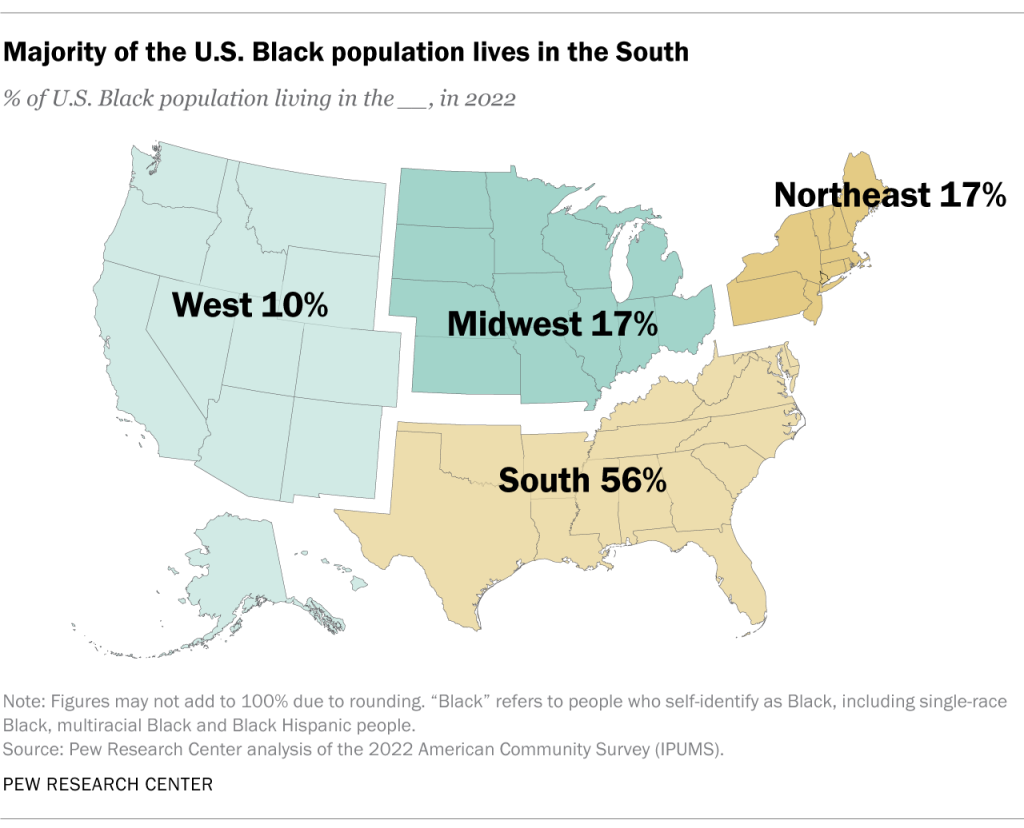
What characterizes the oppression of a nationality? From The Importance of the Black National Question and the Struggle Against National Chauvinism, the authors highlight Stalin’s synthesis on national oppression:
“”J.V. Stalin explains: “What is national oppression. National oppression is the system of exploitation and robbery of oppressed peoples, the measures of forcible restriction of the rights of oppressed nationalities, resorted to by imperialist circles. These, taken together, represent the policy generally known as a policy of national oppression.”“7
“Elsewhere, Stalin summarizes: “Oppressed nationalities are usually oppressed not only as peasants and as urban working people, but also as nationalities, i.e., as the toilers of a definite nationality, language, culture, manner of life, habits and customs. The double oppression can not help revolutionising the labouring masses of the oppressed nationalities, cannot help impelling them to fight the principal force of oppression – capital.” This analysis applied to the U.S. reveals how the U.S. today is truly a prison-house of oppressed nations and national minorities. The U.S. is a multi-national state. However, it differs from the Eastern European multinational States. The eastern European multi-national states like Russia (before the October Revolution), Hungary, Austria, arose in the epoch of the rise of capitalism and nation-states. The U.S. multi-national state developed both in the epoch of mercantile capitalism and in the epoch of imperialism on the basis of the ruthless annexation and subjugation of most of a continent, and then continued this pursuit of “manifest destiny” right into the Pacific and the Caribbean.”8
In highlighting the distinction between race and nationality, national oppression has particularities with Black Americans; African and Caribbean immigrants still face anti-Black racism, but many fall into the category of “national minority” as outlined by the aforementioned paragraph. Unless they assimilate culturally and economically with Black Americans, the anti-Black racism faced by these immigrants is not of a national character. The history of national oppression of Black Americans survives through institutional racism in the form of mass incarceration, targeted policing, workplace discrimination, and a whole host of other forms of suppression and erasure of our culture.
The liquidation of the national question centered primarily on the characteristic of economic life and territory, as the industrialization of and migration out of the Black Belt present a different picture than the one on which the CPUSA’s Black Belt Thesis was formed. As stated in the Liquidationism on the Afro-American Nation by Workers Viewpoint Organization:
“Industrialization in the Black Belt is not, as is generally the case in colonies properly speaking, in contradiction with the ruling interest of the imperialist bourgeoisie, which has in its hands the monopoly of the entire industry, but insofar as industry is developed here, it will in no way bring a solution to the question of living conditions of the oppressed Negro majority, or to the agrarian question, which lies at the basis of the national question.”9
On the “common economic life” of the Black Nation:
The Black Belt:
In “On the Right to Self-Determination for the Negro People in the Black Belt”, Claudia Jones addresses the much contended question of economic life:
“Have the Negro people a stable community of economic life? First, let us discuss what is meant by a common economic life. It is sometimes said that people have a common economic life when they make their living in the same way—they are all sharecroppers, or they are all workers. Actually, a common economic life with reference to a nation or community under capitalism means that the nation or community has within it the class and social relations that characterize society; it has capitalists, workers, farmers, and intellectuals, ranged according to their position in the production relations. In this case it means that a Negro must be able to hire a Negro, buy from a Negro, sell to a Negro, service a Negro.”10
“Such class stratification exists among the Negro people in the Black Belt. There is a Negro bourgeoisie. It is not an industrial bourgeoisie. It is not a big bourgeoisie; the bourgeoisie of an oppressed nation never is; it is one of the results of national oppression that the bourgeoisie of the oppressed nations is retarded by the oppressors. The market of the Negro bourgeoisie is founded upon Jim-Crowism; it functions chiefly in life insurance, banking, and real estate. Its leadership among the Negro people is reflected in an ideology—petty-bourgeois nationalism, whose main purpose is to mobilize the Negro masses under its own influence.” 11
Black-owned firms of today’s economy are mostly concentrated in the Southern U.S. and Mid-Atlantic regions. With the aforementioned 56% of the Black population living this region (and a trend of re-migration from the rest of the country), it should come as no surprise that the class stratification here is more apparent. According to the Pew Research Center’s article A look at Black-owned businesses in the U.S.12, there is an unbroken chain of states with at least 3.1 to 5.0% of Black-owned firms in the deep south with the greatest concentrations in urban areas in Georgia and Maryland. 87% of these businesses are in urban areas, while 5% are in rural areas.13
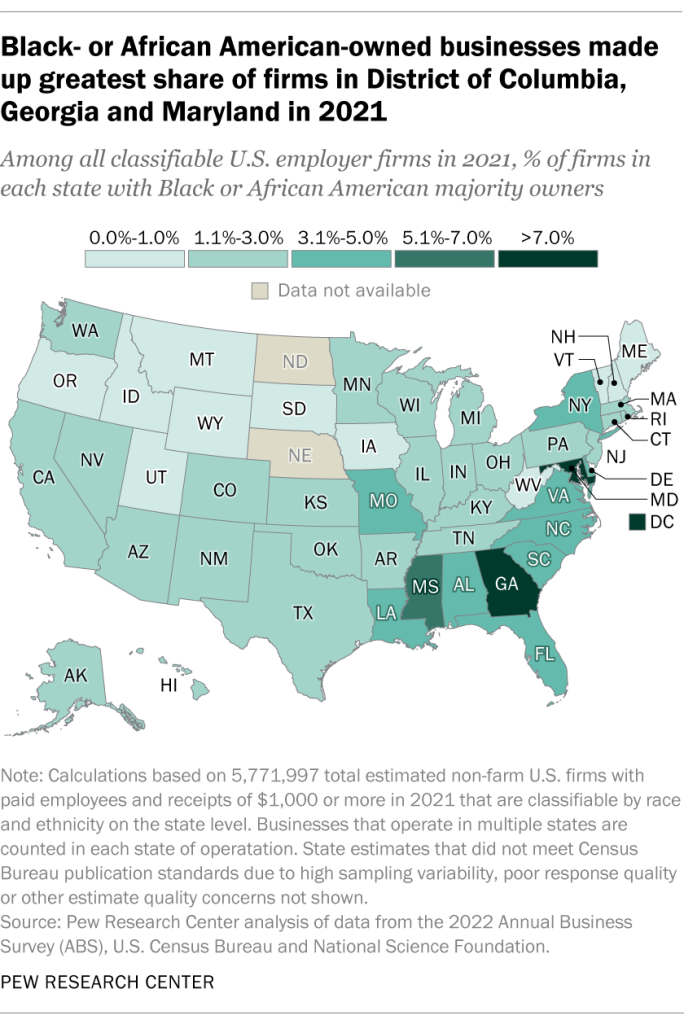
In line with Claudia Jones’ analysis, the Black bourgeoisie is not primarily an industrial bourgeoisie. A plurality of Black firms are concentrated in ‘Health care and social assistance’, ‘Professional, scientific and technical services’ sectors. However, according to the Top 100 List from Black Enterprise, the greatest concentration of wealth is found in the Technology and Manufacturing sectors, representing 38.16% and 24.38% respectively. 14
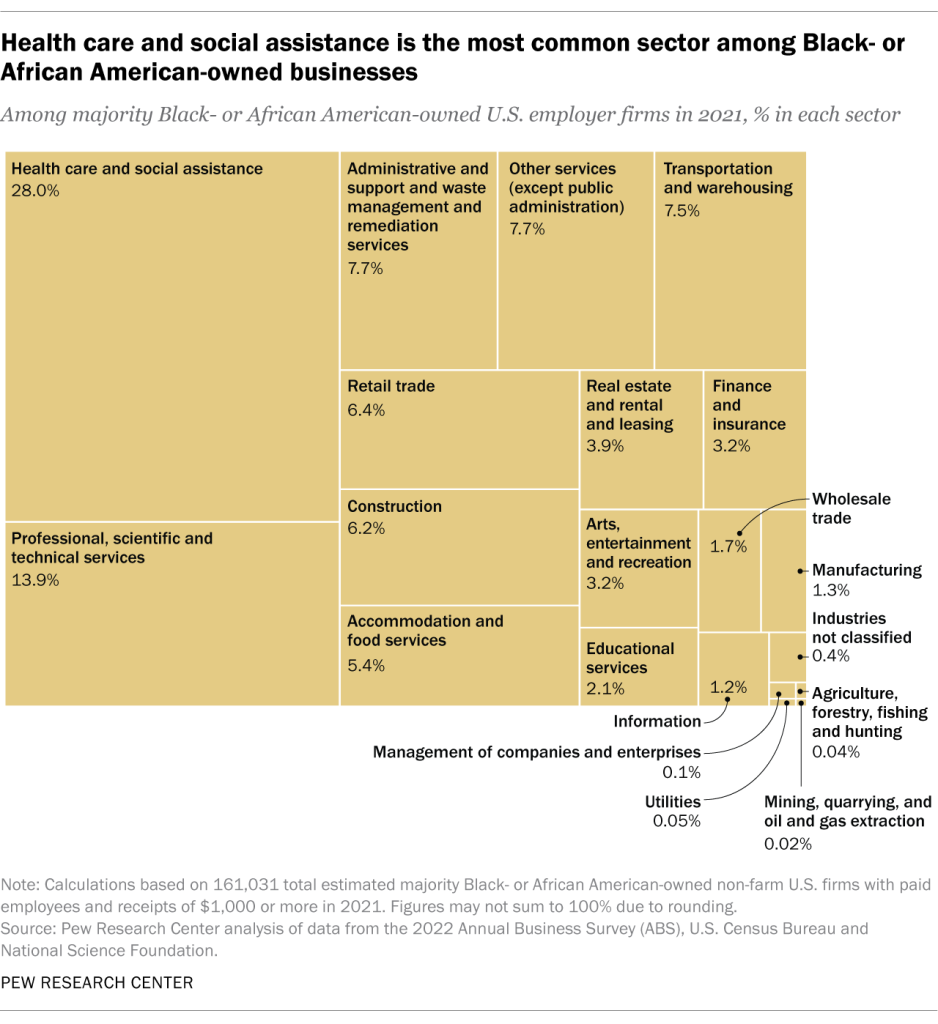
In line with the aforementioned selling out of the Black national struggle by the CPUSA in the 40’s, the Black bourgeoisie was able to lead the civil rights movement and remove the legal barriers to entry into full participation in the economy of U.S. imperialism. The Black bourgeoisie has a dual character in serving as the bourgeoisie of an oppressed nation as well as part of the overall American bourgeoisie.It should also be noted that with the geographic distribution of the population, none of the top ten largest firms are located within the Black Belt. Only three of the ten are contained within the Washington, D.C. metro area which is a major Black population center outside of the region. Of the top 100, 16 are located within the historic Black Belt states, with a high concentration in the Atlanta metro area.15 There are several in southern states adjacent to the Black Belt, such as Texas and Florida. This suggests stratification within the Black big bourgeoisie and petite bourgeoisie, as there is a higher concentration of smaller firms in the Black Belt and in Georgia in particular.
“By these distinguishing features, therefore, the Negro people in the Black Belt constitute a nation. They are an historically developed community of people, with a common language, a common territory, and a common economic life, all of which are manifest in a common culture.”16
The Black Proletariat
It logically follows that with 56% of the Black population living in the U.S. south, the majority of the Black working class would be located in this region. According to the Bureau of Labor Statistics’ (BLS) 2016 African Americans in the U.S. Labor Force, the historic Black Belt states as well as the DC Metro area and Maryland have the highest Black labor force participation in the U.S.17
For states, Mississippi has the highest percentage at 36.3%, followed by Georgia and Louisiana, while D.C. outranks all three states at 37.2%.18
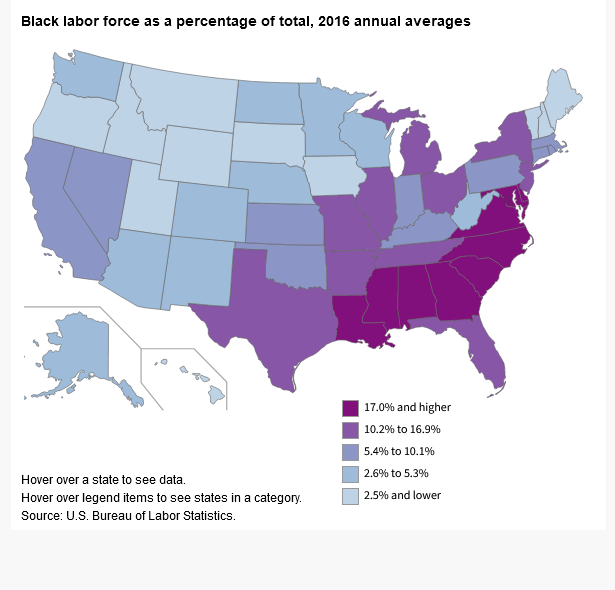
The Black proletariat, like much of the U.S. proletariat in overwhelmingly represented in the service sector at 21.5%. With the increased automation of manufacturing in the U.S., the makeup of the Black industrial proletariat has shifted significantly. 5.9% are in Production, 2.9% are in Construction and extraction, and 11.4% are in material transport and moving. Black people have been historically excluded from the more skilled trades in the workforce due to racist hiring practices and the established “state” unions, which routinely uphold white supremacist exclusionary practices.19 The rest of the workforce as provided by the BLS report shows that 47.7% of Black Americans in sectors entailing professional and administrative work, as well as other positions that would be classified under intellectual labor. It is difficult to know the precise breakdown and stratification of these sectors, as well as overlap between sectors, but from this we can estimate that aound 52.3% of the Black American workforce are wage workers, with the semi-proletariat and petite bourgeoisie comprising the rest of the workforce. It is also worth nothing that in the study of BLS’ 2016 African Americans in the U.S. Labor Force, Black women are projected to outpace Black men in labor force participation by 2026.20
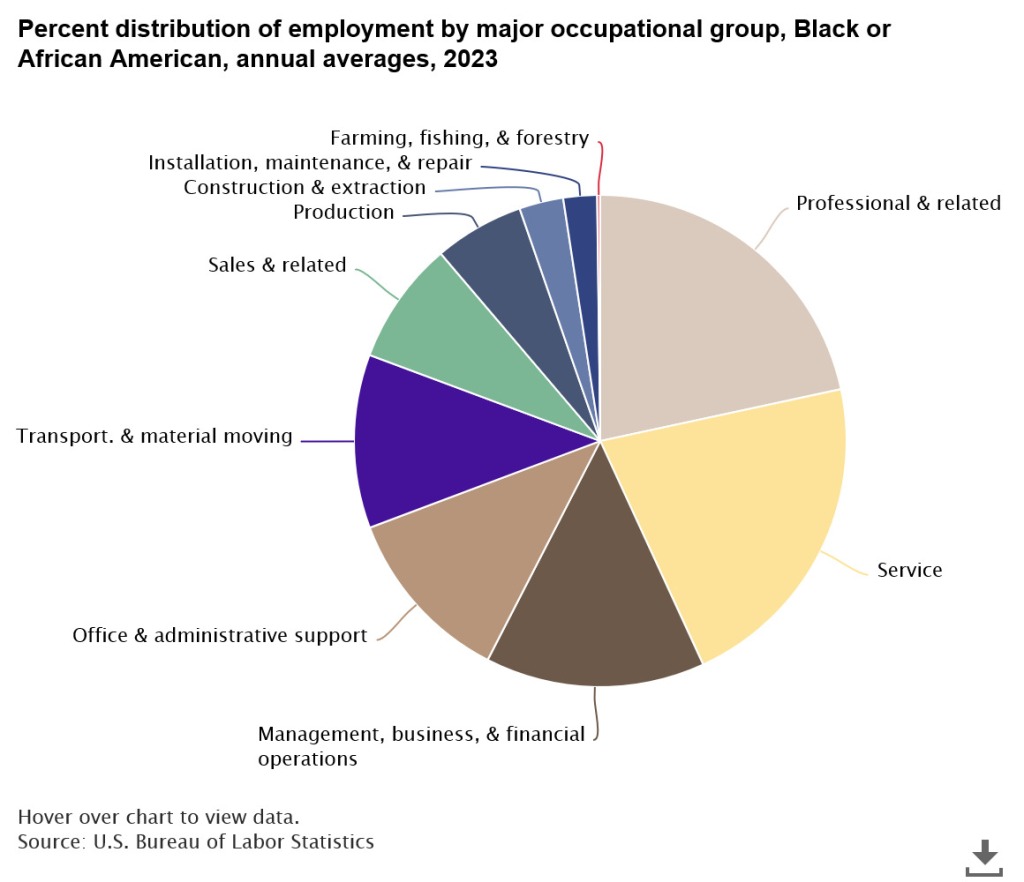
The Black Unemployed and Mass Incarceration
The proletariat in the U.S. is racially stratified, which should come as no surprise to anyone with a semblance of knowledge of U.S. history. The unemployment rates for Black and Indigenous workers are nearly twice the average rate of the total population at slightly over 6%, as recorded by the BLS’ Labor force characteristics by race and ethnicity, 2022 report: 21
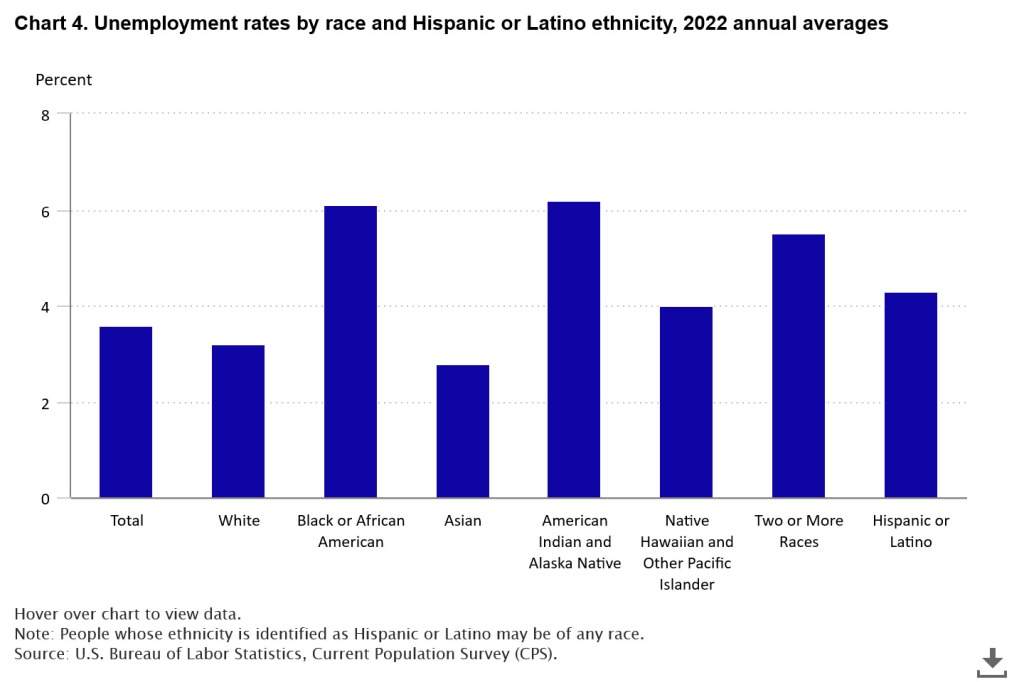
The over-representation in the reserve army of labor is a key component of national oppression, Black Americans are far less likely to be hired than other workers and more likely to be fired. This precarious situation makes participation in the regular labor force more difficult to sustain for Black people, and this puts many of us in closer contact with the state. Through a combination of barriers to participation in the workforce and an increased police presence in our neighborhoods , we are often forced into the “lumpen-proletariat” of the illegal economy to make ends meet and subsequently punished disproportionately for it. In a future piece, we can take more time to delve into the history of the War on Drugs and its weaponization against the Black Power movement, as well as the period of Mass Incarceration beginning in the 90’s. However, it is enough to point out that national oppression is responsible for the over-representation of Black people in the prison system:
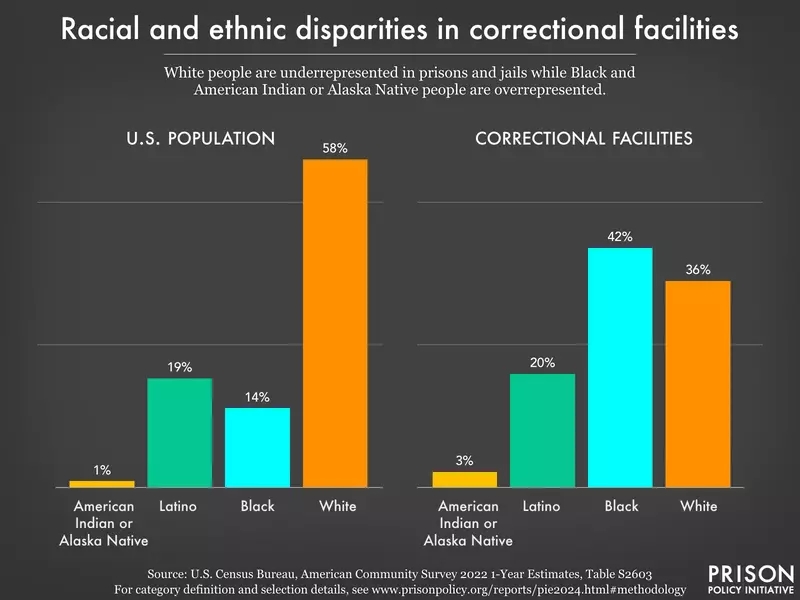
Conclusion
The goal of this piece was to elaborate on the economic nature of the Black Belt today and why it is still crucial to use the 1928-1930 Comintern Resolutions as a starting point for understanding the nature of Black oppression. Black Americans are still a distinct nation of people with our own culture that is still routinely suppressed by U.S. Imperialism. We have class stratification within our community, and nearly 60% of us still live in the geographic region that birthed our national oppression. While The Crusader recognizes that Black Americans in the U.S. are oppressed as a nation, we recognize that it is only the Black proletariat as a class that can lead the national liberation struggle to its end. The Black bourgeoisie has sold out the struggles of Black people in order to join the U.S. imperialist bourgeoisie; the Black petite bourgeoisie can be won over, but its immediate class interests align with the continued existence of capitalism and small-scale production; individual members of the Black lumpen-proletariat can be revolutionary, and often are radicalized by the conditions of life forced upon them by national oppression. However, it is only the Black proletariat that is large enough as a class and whose long-term interests lie in socialized production that can lead the struggle. It is only the Black workers who have the leverage to shut down the machine responsible for the barbaric oppression of all of our people.
The struggle for national liberation and the struggle for socialist revolution are interconnected, and the Communist Party must deliberately recognize the struggles of the nationally oppressed peoples in the U.S. as a component part of uniting the entire proletariat. We advance the correct line of self-determination for the Black Belt, as well as regional and cultural autonomy in areas where Black Americans constitute a majority. If the rights of the nationally oppressed are not deliberately championed in party and organizational programs, as well as upheld in practice, the Party will fail in its historic task. The workers’ movement as well as the Black liberation movement and liberation movements of other oppressed peoples will not succeed unless they are wielded firmly together. The struggles of the nationally oppressed must play a leading role in the labor movement.
“The Party must link up the struggle on behalf of the Negroes with the general campaigns of the Party. The Negro problem must be part and parcel of all and every campaign conducted by the Party. In the election campaigns, trade union work, the campaigns for the organization of the unorganized, anti-imperialist work, labor party campaign, International Labor Defense, etc., the Central Executive Committee must work out plans designed to draw the Negroes into active participation in all these campaigns, and at the same time to bring the white workers into the struggle on behalf of the Negroes’ demands. It must be borne in mind that the Negro masses will not be won for the revolutionary struggles until such time as the most conscious section of the white workers show, by action, that they are fighting with the Negroes against all racial discrimination and persecution.“ 22
- CPUSA, The 1928-1930 Comintern Resolution On The Negro Question In The United States, http://www.marx2mao.com/Other/CR75.html ↩︎
- Bolshevik League of the United States, The Importance off the Black National Question and the Struggle Against National Chauvinism, https://www.marxists.org/history/erol/ncm-7/bl-introduction.htm ↩︎
- Stalin, J.V., Marxism and the National Question,https://www.marxists.org/reference/archive/stalin/works/1913/03a.htm ↩︎
- Pullum, Geoffrey, African American English is not Standard English With Mistakes, Stanford University, https://web.stanford.edu/~zwicky/aave-is-not-se-with-mistakes.pdf ↩︎
- Moslimani, Tamir, et al. Facts About the U.S. Black Population, Pew Research Center, https://www.pewresearch.org/social-trends/fact-sheet/facts-about-the-us-black-population/#:~:text=In%202022%2C%20there%20were%20an,14.4%25%20of%20the%20country’s%20population.↩︎
- Stalling, Nicole, Double Consciousness: W.E.B. Du Bois’ Profound Concept, W.E.B. Du Bois Directory, https://duboisweb.org/double-consciousness-web-du-bois-profound-concept/ ↩︎
- Bolshevik League of the United States, The Importance off the Black National Question and the Struggle Against National Chauvinism, https://www.marxists.org/history/erol/ncm-7/bl-introduction.htm ↩︎
- Ibid. ↩︎
- Workers Viewpoint Organization, Liquidationism on the Afro-American Nation: CPUSA, 1919-1940, https://www.marxists.org/history/erol/ncm-8/wvo-cpusa-race.htm ↩︎
- Jones, Claudia, On the Right to Self-Determination for the Negro People in the Black Belt,, https://www.marxists.org/history/usa/pubs/political-affairs/1946-05v25n5-political-affairs.pdf ↩︎
- Ibid. ↩︎
- Leppert, Rebecca, A look at Black-owned businesses in the U.S., Pew Research Center, https://www.pewresearch.org/short-reads/2024/02/16/a-look-at-black-owned-businesses-in-the-us/ ↩︎
- Ibid. ↩︎
- Black Enterprise, The Nation’s Largest Black Businesses,https://www.blackenterprise.com/be100s/ ↩︎
- Ibid. ↩︎
- Jones, Claudia, On the Right to Self-Determination for the Negro People in the Black Belt, https://www.marxists.org/history/usa/pubs/political-affairs/1946-05v25n5-political-affairs.pdf ↩︎
- Toossi, Joyner,African Americans in the U.S. Labor Force, Bureau of Labor Statistics, https://www.bls.gov/spotlight/2018/blacks-in-the-labor-force/home.htm#:~:text=BLS%20projects%20that%20the%20labor,at%2063.9%20percent%20in%201999↩︎
- Ibid. ↩︎
- Bureau of Labor Statistics, More than a Century of Occupational Changes among African American Workers, https://www.bls.gov/blog/2024/more-than-a-century-of-occupational-changes-among-african-american-workers.htm ↩︎
- Toossi, Joyner,African Americans in the U.S. Labor Force, Bureau of Labor Statistics, https://www.bls.gov/spotlight/2018/blacks-in-the-labor-force/home.htm#:~:text=BLS%20projects%20that%20the%20labor,at%2063.9%20percent%20in%201999↩︎
- BLS Reports, Labor force characteristics by race and ethnicity, 2022, Bureau of Labor Statistics, https://www.bls.gov/opub/reports/race-and-ethnicity/2022/home.htm ↩︎
- CPUSA, The 1928-1930 Comintern Resolution On The Negro Question In The United States, http://www.marx2mao.com/Other/CR75.html ↩︎
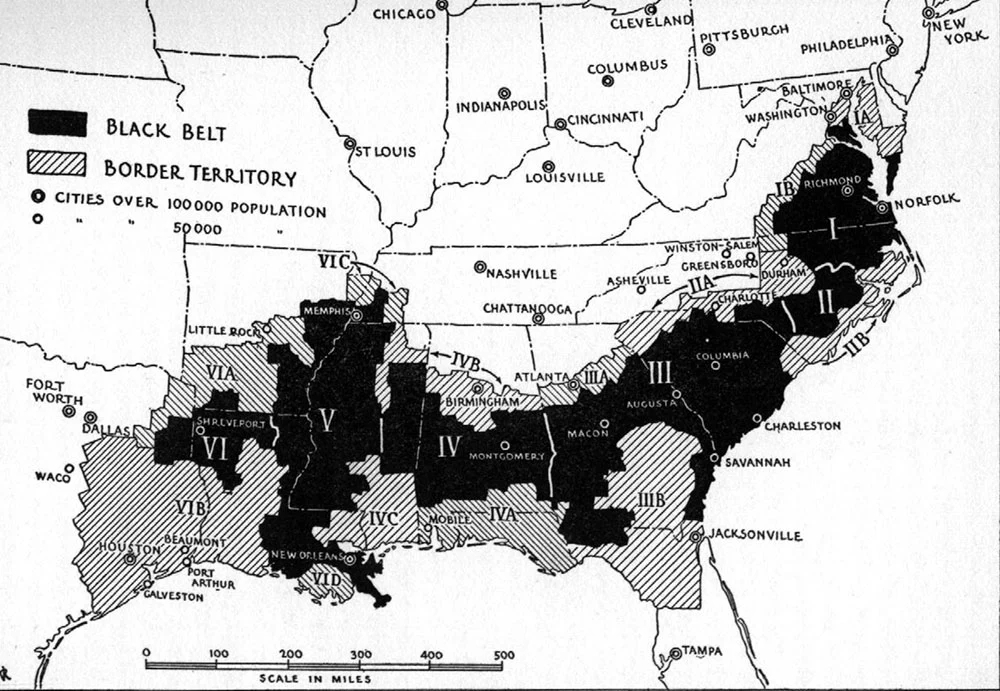
Leave a comment